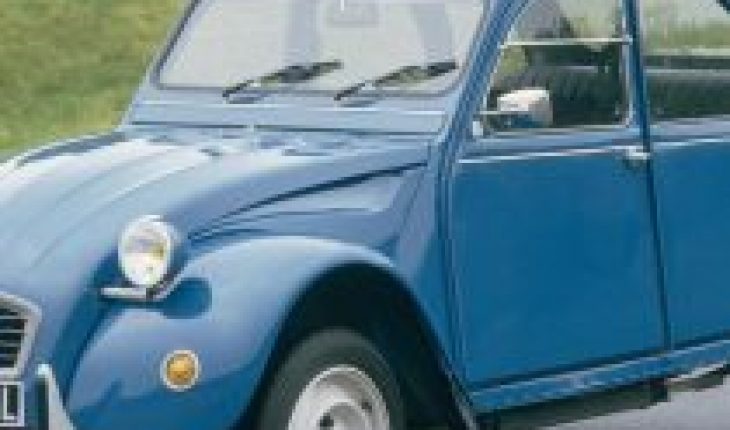
This week marked the 30th birthday of the end of an era. On 27 July 1990, at the Citroen assembly plant in Mangualde,Portugal, the last 2CV of history came out of the production line. At 4pm that day, unit 5,118,889 was produced, a significant number for those years, when vehicle production and sales volumes were limited by the uniqueness of the different markets.
With chassis number AZKA0008KA4813, the last model in production was a 2CV 6 Charlestone, with two-tone bodywork in dark and light gray, and which was honored in a short ceremony that included a band. Right there it was handed over to its owner, ironically the same manager of Mangualde, Claude Hebert.
Thus ended one of the most important chapters not only the brand, but of the automotive industry as a whole. A project that was born in the period between wars thinking about the motorization of France, which was presented timidly at the Paris Salon of 1948, and that over the years became a true legend all over the world.
In Chile, the model was not only manufactured in its original configuration at the citroen assembly plant in Arica, but also in an unprecedented “pick-up” or truck variant, which was marketed under the name Citroneta.
In fact, a few years ago this model was chosen in a popular vote as the “Auto of the Century” in our country.
Work of a genius
The real genius with the 2CV was to devise a simple, functional and accessible model, which allowed the masification of the car in post-war France, something that until then was reserved for the people of higher incomes.
It was in 1934, however, long before the outbreak of World War II, that Citroen’s new CEO, Pierre-Jules Boulanger, approved the project of developing a vehicle of mass consumption, economical cost and use, safe for its occupants, and so versatile, that it should be able to transport with maximum comfort four people and 50 kilos of luggage , at a speed of 60 kilometers per hour.
It was not a personal project of Boulanger, but the continuation of an idea born in the genius of André Citroen. From his early days as an automaker, the great dream of the brand’s founder was to power France in the same way henry Ford had done with the Model T in the United States.
It was then that the letters POS (Toute Petite Voiture) came into play, an affectionate appellate for the ambitious project of developing a compact utility, which would adapt perfectly to the needs of a still very rural society, which needed to modernize to improve its displacement.
Comfort and habitability were two key points for the new POS. Therefore, the first relevant element was the suspension, which was worked on the slogan that the car could transport a basket with eggs through the difficult rural roads of 1930s France, without any breaking.
The second point had to do with habitability, which, as we said, should be enough to bring four adults. The point of measurement of the designers was Boulanger himself, who was a fairly tall man, and who should be able to get in the car with his hat on: if he fell in the attempt, the prototype was destroyed.
The result of this experiment was an extremely simple model with a unique design, the work of the genius of Flaminio Bertoni. It had a lightweight corrugated aluminum body that allowed it to weigh only 370 kilos in dry, seats that hung from a tubular structure on the roof, more like hammocks than conventional seats, and with a cost so narrow, that it was a third of the value of the 11 hp that at the time sold Citroen.
And then there was the engine, much smaller than usual for the time, with two cylinders, which generated 9 horsepower, equivalent to the fiscal power of two horsepower. Hence his final name, Deux Chevaux Vapeur or 2CV.
The results of the tests were going from strength to strength and the POS demonstrated its good qualities, so by 1939 there had already been 250 prototypes of the 2CV at the Levallois factory, and they were to be presented at the Paris Motor Show that year, something that ultimately did not happen after the outbreak of World War II. France was soon occupied by the Nazis and in Citroen was given the order to make the prototypes disappear so that they would not fall in the hands of the Germans.
The vehicles were deliberately destroyed, however, some of those involved in the project refused to sacrifice hundreds of hours of work and by hiding some of these early units, keeping studies of prototype development safe. Five of those units have lasted to this day. Three of them were found in 1994 inside an inaccessible barn on a farm located in the Citroen Test Center in La Ferté-Vidame.
At the end of World War II, the project continued and significant changes were introduced, such as a new air-cooled 375cc engine, a new four-speed gearbox and seat redesign. In addition, the aluminum of its body was replaced with a more robust steel.
It was on October 6, 1948, when the doors of the Paris Salon opened for the public, that Citroen presented in partnership the first 2CV called “Type A”. The model reached 65 km/h, stood between 20 and 25 kilometers per liter and was only available in grey.
The Citroen 2CV was unveiled in front of the President of the Republic of the time, Vincent Auriol, and left the crowd open. While some mocked its original silhouette, others saw in it all the qualities still lacking in many models: simplicity, lightness, agility, comfort, versatility…
From the earliest days, the number of orders gave reason to the brand and its visionary designers. André Lefebvre, Citroen’s director of design and product, equipped the 2CV with a number of ingenious technologies for the time: front-wheel drive, flexible long-haul suspension, air-cooled two-cylinder engine, etc.
Evolutions
With 42 years of uninterrupted production, the 2CV was not only left in the iconic model presented in Paris, but evolved into mechanics, technology, but also an ingenious body offering.
The first appeared at the 1950 Paris Salon and was the 2CV Van, a tool designed by farmers to move loads at low cost. It had suspension with springs and friction dampers, which allowed to move up to 500 kilos. Its success was such that more than 1.2 million units were produced in
Everybody.
In 1956 the 2CV “Type AZL” appeared, with a 425 cc engine. reaching 70 km/h. That same year the 2CV van “Type AZU” was presented, and two years later, after several intermediate models, the first 4×4 version of the 2CV appeared, which bore the name “Sahara”.
In the 2CV Sahara two 425 cc. engines were mounted, each with its own gearboxes and transmissions, so that each operated an axle of the car. Thus it was possible to have a car of all-wheel drive, with controlled weight and very effective suspensions, ideal to move around all kinds of terrain. Today, this peculiar Citroen exceeds 50,000 euros in the collection car market.
In 1960, the power of the 2CV “AZLP type” rises to 13.5 Hp, and the top speed to 85 km/h, with consumption slightly below 20 km/litre. In addition, the five-nerve hood was introduced into 2CV vans. In 1968, the 2CV van “Type AZU” incorporated a new 425 cc engine. hp at 5,250 rpm, allowing it to reach 80 km/h.
Finally, in 1968 one of the most admired versions of the 2CV is uncovered by all: in Mehari. It had a lightweight fiberglass body, sported a “buggy” design and could easily decay, becoming the favorite vehicle on European beaches.
In 1974 the largest aesthetic modifications were made to the 2CV, introducing rectangular headlights instead of the fillets, and a plastic protection band was incorporated into the bumpers and a roof inside the doors.
In 1981, the 2CV6 starred in the first half hour of the James Bond film “For you eyes only”, where she was able to demonstrate her skills in one of the most remembered chases in cinema.
The 2CV In Chile
In 1953, this peculiar model was crossed with Chile when the project of assembly of units in the city of Arica began. The French company officially established itself as a producer in 1957 under the name Citroen Chilena S.A., debuting with the iconic national version with rear case and equipped with the new engine released in France in October 1954: 425 cc and 13.5 Hp.
In the early 1960s the first 2CV “AZU Type” began to be manufactured in Chile, which had four doors, metal roof and trunk. This was the model that Chileans affectionately dubbed “Citroneta”, a name that derives from the mixture between Citroen and van, since this model was sold with a small pick-up or open rear trunk, which allowed taxes to be deducted. This “made in Chile” model remains an icon of the model’s history and attracts numerous collectors from around the world.
By 1970, President Salvador Allende asked Citroen Chile to build a Jeep-like utility for the army, thus the Yagan project was born. However, the model did not pass the resistance tests, so the army scrapped the production contract and the Yagan went to the general public, trading itself as a “Chilean Mehari”.
In August of that year the AX330 appears with a 33-horsepower engine with a displacement of 600 cc. which allowed the 2CV to reach a speed of 120 km/h.
Production in Arica ended in 1979 due to strong competition from Japanese vehicles, which made it economically unworkable to maintain domestic production.
By 1983, Citroen ceased to import the 2CV6 model, ending one of the most iconic four-wheeled stories in the national automotive industry.
The end
On 27 July 1990, after many technical modifications and special editions, the manufacture of the 2CV ceased at the global level. After 41 years, 8 months and 21 days of uninterrupted production, a total of 5,118,889 units were sold, where 3,872,583 corresponded to 2CV and derivatives, and 1,246,306 were with van bodywork.
The Citroen 2CV became a real social phenomenon: it was the favorite car of farmers, but also of urban families and students. This explains an exceptional 42-year lifespan and more than 5.1 million units sold worldwide.





